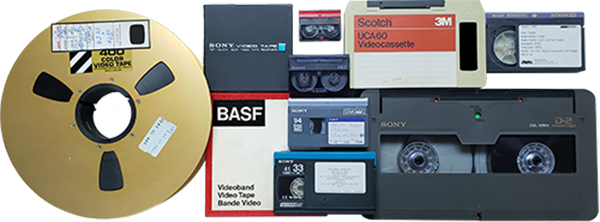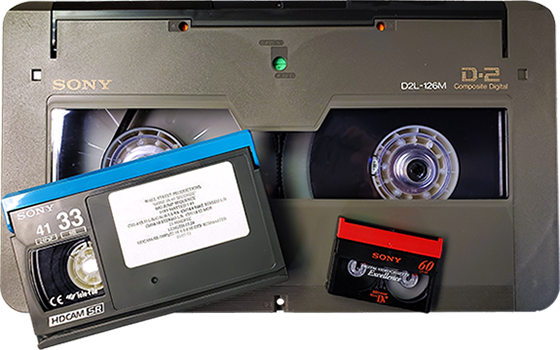OBSOLETE VIDEO MEDIA FORMAT RESTORATION & PRESERVATION WORKFLOW
with XML METADATA
Your at-risk videotapes are acclimatized for 24-hours in an STP static-free, temperature and humidity-controlled, positive-pressure clean room with no access to sunlight. Your media and cases are then photographed and logged using Structured XML Metadata, documenting their journey toward restoration, digitization, and preservation.
MANUAL MEDIA INSPECTION & REPAIR

Your media is carefully inspected for reel and shell integrity, as well as evidence of sticky-shed syndrome and mold. If your video cassette shell is warped or damaged, we can remove the inner take-up and supply reels from their housing and place them inside new shell enclosures. We keep a large supply of replacement video shell housings for all video formats, ensuring your irreplaceable, at-risk media is successfully recovered.
REVERSING STICKY-SHED SYNDROME

As magnetic tapes age, the binders holding the oxide particles deteriorate causing Sticky-Shed Syndrome. As oxide flakes off, signals can become unrecoverable. Our engineers can scientifically reverse the effects of Sticky-Shed Syndrome through Reverse Hydrolysis. This involves slowly heating your tapes in a Laboratory Vacuum Furnace, while controlling the temperature to within 1° degree. Humidity is carefully monitored, as is the Curie Point of your media’s particular magnetic particle formulation. After many hours or days of such treatments, your media regains many of its youthful properties and successful digitization can occur.
STRUCTURED XML METADATA LOGGING
For every project, we create metadata following DCMI, Dublin Core. We also use LMER & PREMIS Data Models as well as NIEM and Library of Congress ANSI/NISO Z39.8 standards for descriptive, structural, administrative, rights management, and preservation metadata.
EXTENSIVE VIDEO FORMAT SUPPORT
From Low-Band 2” Quadruplex and 1“ Type C Helical to SxS, REDMAG, and dozens of formats in between, we support more video formats than any other company.
Analog Video
Open Reel Video
| 2-inch Quadruplex Low Band |
| 2-inch Quadruplex High Band |
| 1-inch Type A open reel |
| 1-inch Type B open reel |
| 1-inch Type C open reel |
| AKAI AK-VT (B&W) ¼” open reel |
| EIAJ Type 1 (B&W) ½” open reel |
| EIAJ Type 2 (Color) ½” open reel |
| Concord NV (B&W) ½” open reel |
| Panasonic NV (B&W) ½” open reel |
| Panasonic CV (Color) ½” open reel |
| Skip Field NV (B&W) ½” open reel |
| Technicolor CVC ½” open reel |
Analog Video Cartridge
| Sanyo Vcord I |
| Sanyo Vcord II |
| Philips N1500 ½” Video Cartridge |
| Philips N1700 ½” Video Cartridge |
| Philips N2000 ½” Video Cartridge |
Analog Video Casset
| ¾” U-Matic |
| ¾” U-Matic SP |
| VCC Video 2000 V2000 ½” |
| Betamax ßI |
| Betamax ßII |
| Betamax ßIII |
| Super Betamax (High-Band) |
| Extended Definition Betamax ED Beta |
| Betacam |
| Betacam SP |
| Betacam SX |
| Betacam IMX |
| VHS |
| VHS-C |
| S-VHS |
| Panasonic M |
| Panasonic MII |
| 8 mm Video8 |
| Hi-8 |
Digital Video
Digital Video Casset
| Digital 8 |
| Digital Betacam |
| HDCAM |
| HDCAM-SR |
| D-1 component |
| D-2 composite |
| D-3 composite |
| D-5 component |
| D-5 HD component |
| D-5 2K component |
| D-9 Digital S |
| DV MiniDV |
| HDV |
| DVCAM |
| DVCPRO |
| DVCPRO 50 |
| DVCPRO 100 HD |
Digital Video Cartridge
| Panasonic P2 |
| REDMAG |
| RED MINI-MAG |
| ARRI CFast 2.0 |
| ARRI Codex |
| ARRI Codex XR |
| ARRI Codex SXR |
| Sony SxS |
| Sony SxS Pro card |
| Sony SxS Pro+ card |
| Sony AtomX SSDmini |
| AJA Pak SSD Module |
Optical Video Disc
| Muse HD Laserdisc |
| RLV WORM Laserdisc |
| CDi Digital Video |
| CD Video 8” |
| VCD Video CD |
| CAA LaserDisc |
| CAV LaserDisc |
| CLV LaserDisc |
| CRVdisc |
| SVCD |
| DVD Digital Versatile Disc |
| HD DVD |
| Blu-Ray |
| 4K Ultra HD BD |
| XDCAM PFD |
| XDCAM HD |
VIDEO MEDIA PRESERVATION FORMATS
We directly encode to all preservation formats & codecs, avoiding concatenation errors caused by transcoding. Click HERE for a list of supported formats and codecs.
OPEN REEL VIDEO TAPE DIGITIZATION

Obsolete, open-reel video tape formats are most at-risk of unrecoverable content loss. Their chronological age and manufacturing methods form a death sentence whose peak recovery period passed decades ago. Now, it’s a race to recover what video remains. The broadcast formats of 2-inch Quadruplex and 1-inch Helical are as endangered as their ½” EIAJ and ¼” AKAI cousins. Trust the experts at AVConservation.org powered by Wall Street Productions to give your aging, brittle open-reel video tapes the best chance at recovery & preservation.
ANALOG VIDEO CASSETTE DIGITIZATION

Introduced in 1969, analog video cassettes are at risk of becoming unrecoverable. The early oxide formulations of ¾” U-Matic and Betacam are considered the highest preservation risk, as the amount of undigitized media exceeds the capacity of the world’s inventory of working playback machines. Fortunately, we own one of the largest inventories of pristine broadcast VTRs and VCRs maintained by our engineering team. Further, all analog video cassette content is extracted through component outputs, separating luminance detail from the noisier chroma signals. Both are then time base corrected and transferred at 270 megabits per second per ITU-R BT.656 and SMPTE 259M maximum specifications. We can also embed EIA-608 & EIA-708 CC / SCC as well as LTC & VITC, prior to encoding to your chosen format. The result is unparalleled quality with uncompromising results.
DIGITAL VIDEO CASSETTE PRESERVATION

Introduced in 1986, professional digital video cassettes boast a longer shelf life than their analog counterparts. However, they are more at risk as far fewer professional digital video playback machines were manufactured. While the number of consumer digital video cassette players is much higher, the smaller format depended on lossy, low bit rate compression recorded helically on extremely narrow tape widths. Slight misalignments or tape damage result in no playback of picture or sound. You can trust our digital video playback equipment to recover your precarious digital video cassettes. Our all- digital signal path transfers your media at 270 Mbps, 1.483 Gbps, 1.485 Gbps, 2.966 Gbps, or 2.970 Gbps, the highest digital video transfer speeds specified by SMPTE 292M, SMPTE 372M, and SMPTE 424M. We can also embed EIA-608 & EIA-708 CC / SCC as well as LTC & VITC prior to encoding to your final media file format.
OPTICAL VIDEO DISC PRESERVATION

Optical video disc formats are fraught with preservation risks. Replicated formats as CAA, CAV, & CLV Laserdiscs face ever-dwindling numbers of compatible laserdisc players. Recordable optical videodiscs suffer from both a shortage of working optical players and degradation of the dyes retaining the video data. In spite of their invincible appearance, now is the time to rescue all video and photographic content before it’s too late.
LONG-TERM ARCHIVAL MEDIA STORAGE

After digitizing your media to both a long-term archive format and mezzanine service file, you’re faced with how to securely store these files, and whether to retain or destroy your source media. No matter what you decide, we can support you with petabytes of secure file storage, allowing you to enjoy the mezzanine copies without the expense of storing massive archive files. We also offer environmentally-friendly media disposal and long-term cold storage for retaining source media.

